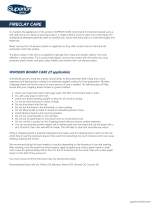
18
GRILL SETUP Place full aluminum salt dredge on sandwich board in front of grill. Do not use fine
flake salt for grill.
Make sure grease buckets are directly under grease chutes.
Place chili meat pan in sandwich board warmer, MPHC drawer or on grill. If holding
chili meat on grill, fill 1/3-sized pan ½ full with water.
Place two grill spatulas on sandwich board in front of grill.
Turn grill on to 250°F. 30 minutes prior to use.
GRILL TOWEL/ During opening, prepare pans of sanitizer solution for each grill.
SANITIZER/ Fill 1/6-sized, 6-inch deep, stainless steel pans 2/3-full of properly mixed
PAN SETUP (200ppm) sanitizer solution dispensed from the Chemical Blend Center.
Place a pan of sanitizer solution in the pan holders located at each grill.
Place a clean, pink colored, disposable towel into each pan of sanitizer solution.
These towels will be used every 15 minutes to help control sanitation of the grill
area.
Place one dry, pink colored towel at each grill.
These towels will remain dry and will be used to soak up blood and
grease from the grill area as needed, but minimally every 15 minutes.
BOILING & Set chili stove to the #4 setting or 560°F.
CHOPPING Assemble the following tools and supplies:
CHILI MEAT Frozen chili meat,
1/2-sized, 6-inch deep, stainless steel pan and slotted lid,
Colander,
Oven mitts,
Rubber apron,
Grill spatulas,
Chili meat chopping tool (if used),
Full-sized, 6-inch deep, stainless steel pan (if using chopping tool).
Remove oldest bags of chili meat from walk-in freezer.
Discard chili meat more than five days old.
Place frozen chili meat into a 1/2-sized, 6-inch deep, stainless steel pan and
discard plastic freezer bag. Do not reuse bags.
Using a grill spatula, break the block of frozen meat in half so that all of the meat
fits into the pan.
Fill pan with hot tap water to within one inch of the top, to cover meat. The hot
water will help separate the frozen meat patties.
Place 1/2-sized, slotted lid on pan and place on the preheated chili stove to boil.
After approximately 45 to 60 minutes on the chili stove, the pan of meat will begin
to boil.
Allow meat to boil for a full 10 minutes to kill bacteria and make meat
easier to chop.
Wearing the rubber apron, remove lid from boiling chili meat and, using oven mitts
to hold pan, pour boiled meat into colander that has been placed over the rinse
(middle) compartment of the three compartment/PowerSoak sink. Caution: Meat
and water are extremely hot; use safety equipment to avoid burns.
There is a minimal amount of grease in this water. The chemicals that are flushed
down the sink when changing the sinks will sufficiently flush the lines.
Press excess water and grease from meat with grill spatula.
Return drained and pressed meat to pan.
Place colander in three compartment sink to be washed and sanitized.
Using two hamburger spatulas, chop meat. Use a piston-like motion by forcing one
spatula down into meat and then the other.
If using the chili meat chopping tool, chili meat should be placed in a full-sized, 6-
inch deep meat pan prior to chopping.
Chop meat until pieces are smaller than a dime but larger than a pea (between
6mm. and 18mm).
!
CAUTION




























